For thermal performance the GTX980 was tested on our thermal bench. This consisted of a 4930K on a Rampage IV Gene motherboard running Windows 7 on a Samsung 840 Pro SSD. Power was provided by a Corsair AX1200. Memory was GSkill 4x8GB 1866-CL11. Thermal monitoring was provided by an Aquaero 6. Temperatures of the Aquaero sensors and GPU sensors were logged by HWInfo. 347.52 WHQL Drivers were used. MSI Afterburner was used to downclock the GPU to a miserable 1151MHz. Furmark was used to load the GPU at 118% of it’s power limit (121% is the maximum power the card can draw). Furmark is used in the higher power burn mode to give a very consistent load over time. This is far more consistent than running Valley for example where GPU load is not as constant as it could be.
In previous water block reviews for GPUs we’ve flashed a modified bios to the GPU to enable us to achieve a higher power limit and test the card at higher power. These readily available bioses were used by many enthusiasts and so we felt it was a “fair” setup. However for the GTX980 there is currently no bios for the reference card that enables this. For this reason we are stuck with NVidia’s absurdly low power limit. The only way to get around this currently is to modify the PCB itself which we think many enthusiasts will not be willing to do. Therefore, likewise we did not do this. This means that the power used (and therefore cooled) by the GPU is so low that a waterblock is not necessary. EVGA’s ACX cooler ran almost silently under the same load and the GPU remained at a moderate 40C over ambient.
This also means that the GPU temperatures with a waterblock are so low that the relative margin of error is huge. To combat the error we measure across seven different flow points – this also give us insight to how the cooling responds with flow. In previous GPU block reviews we’ve also lost a *lot* of GPUs. Installing multiple blocks multiple times coupled with high power levels can quickly kill a card. Because of this we stick to one mount of the block on the GPU. This means that the test data is susceptible to a poor mount. However the TIM used (arctic cooling MX2 – not the included TIM with the block which may be good or bad) is inspected to ensure a good spread. If a good spread is not achieved an immediate re mount is done.
To further reduce errors the core temperature is measured relative to the coolant. Air temperatures are not measured because they are so prone to error. Ambient temperatures are not controlled and are another source of error. As NVidia do not give us access to VRM temperatures a temperature probe is mounted to the PCB in the middle of the VRM section. It should be noted that actual on silicon temperatures will of course be worse than this probe which is not well insulated from the block’s cooling.
Core Cooling
The GPU core itself generates the most heat of course and we were excited to see how XSPC performed. As expected performance still increases across the flow range of interest:
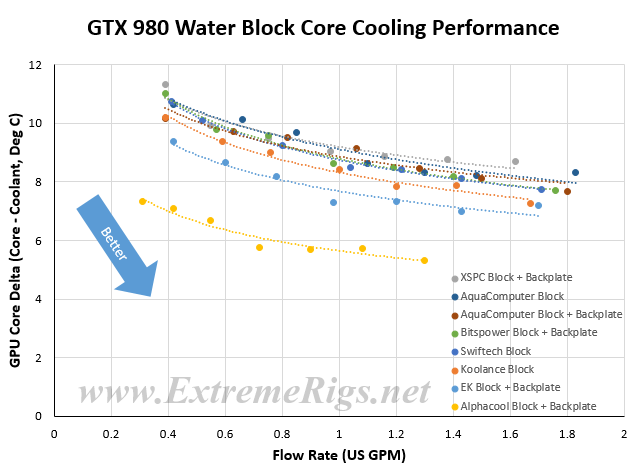
After previously good performance on the Titan and the reasonable looking TIM spread we expected XSPC to do well. XSPC here did quite poorly relatively though and this is perhaps more a reflection that the competition has got better on core performance while XSPC focussed on VRM perfomance.
TIM
Traditionally I’ve only looked at block performance with MX2 TIM, however manufacturers generally supply TIM with the block and so this time I decided to test that. Bitspower were the only manufacturer not to include TIM:
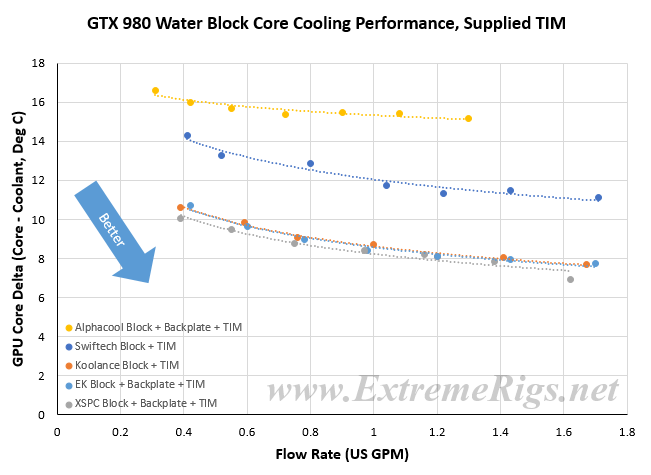 This testing allowed 4 hours for TIM burn in which is simply not enough for some TIMs. However we now see that Koolance, EK and XSPC are all essentially the same when using their own TIM. Swiftech and Alphacool have TIM that is either horrible or has a long curing time. Given the low power nature of the GTX980, we suspect it’s simply a long curing time.
This testing allowed 4 hours for TIM burn in which is simply not enough for some TIMs. However we now see that Koolance, EK and XSPC are all essentially the same when using their own TIM. Swiftech and Alphacool have TIM that is either horrible or has a long curing time. Given the low power nature of the GTX980, we suspect it’s simply a long curing time.
We can then compile all these data points into averages which should take some of the error out:
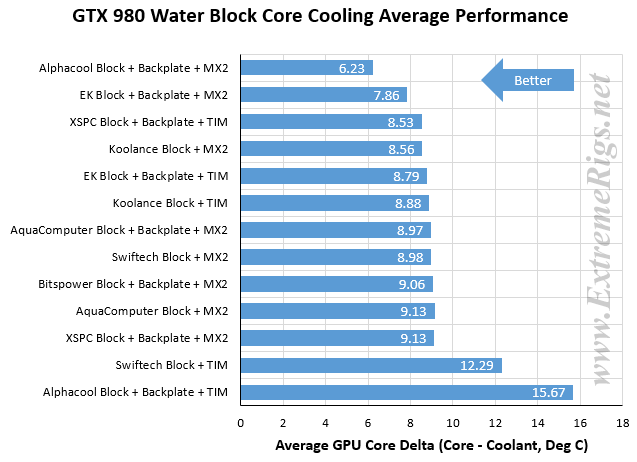 Here we can see that 7/11 data points are within 0.5C. This along with the low absolute values shows just how overkill water cooling really is for a low power GPU like the GTX980.
Here we can see that 7/11 data points are within 0.5C. This along with the low absolute values shows just how overkill water cooling really is for a low power GPU like the GTX980.
By plotting the difference between the MX2 and Supplied TIMs we can take a crude look at the relative TIM performance:
This shows that XSPC’s TIM was very good, in fact the best that was tested. It wasn’t enough however to make up for the cooling engine’s performance.
VRM Cooling
While AMD give us access to a temperature probe built into the VRM section Nvidia does not. Our probe was therefore inserted between a thermal pad and the body of a VRM IC located in the middle of the VRM area. Because it measures IC case temperature and has a thermal pad touching it the temperatures will be significantly lower than the internal silicon temperatures of the IC.
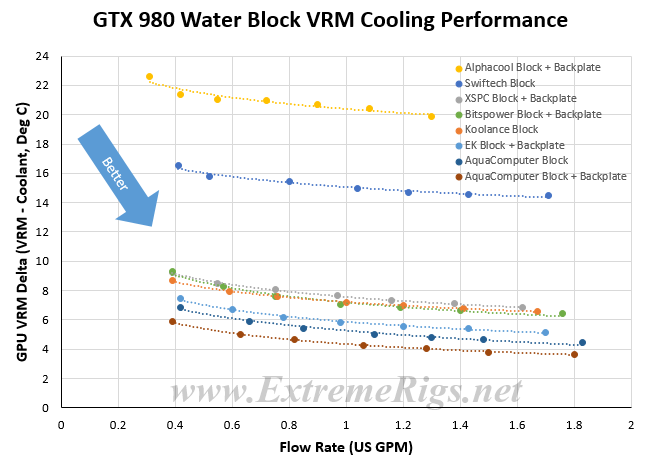
Coolant flow has a weak effect on VRM temps, particularly for blocks with poor performance. Let’s therefore average this to see relative performance more clearly:
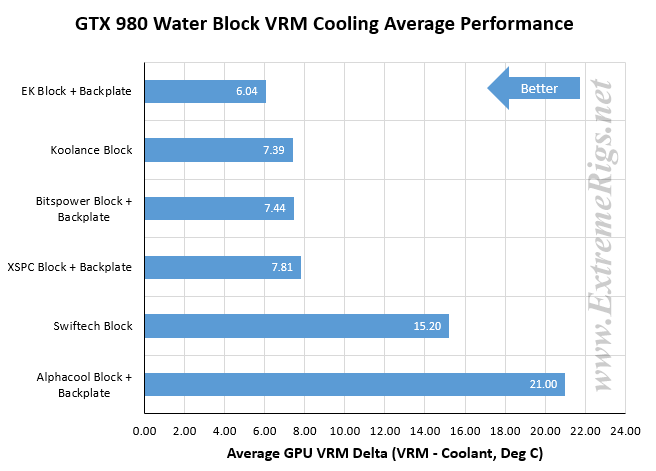 XSPC’s VRM temperatures seemed to be very much the focus of their improvements on this generation and it has payed off. While they are not leading they are very close to the top and this can no longer be considered a weakness.
XSPC’s VRM temperatures seemed to be very much the focus of their improvements on this generation and it has payed off. While they are not leading they are very close to the top and this can no longer be considered a weakness.
Onwards for the summary!








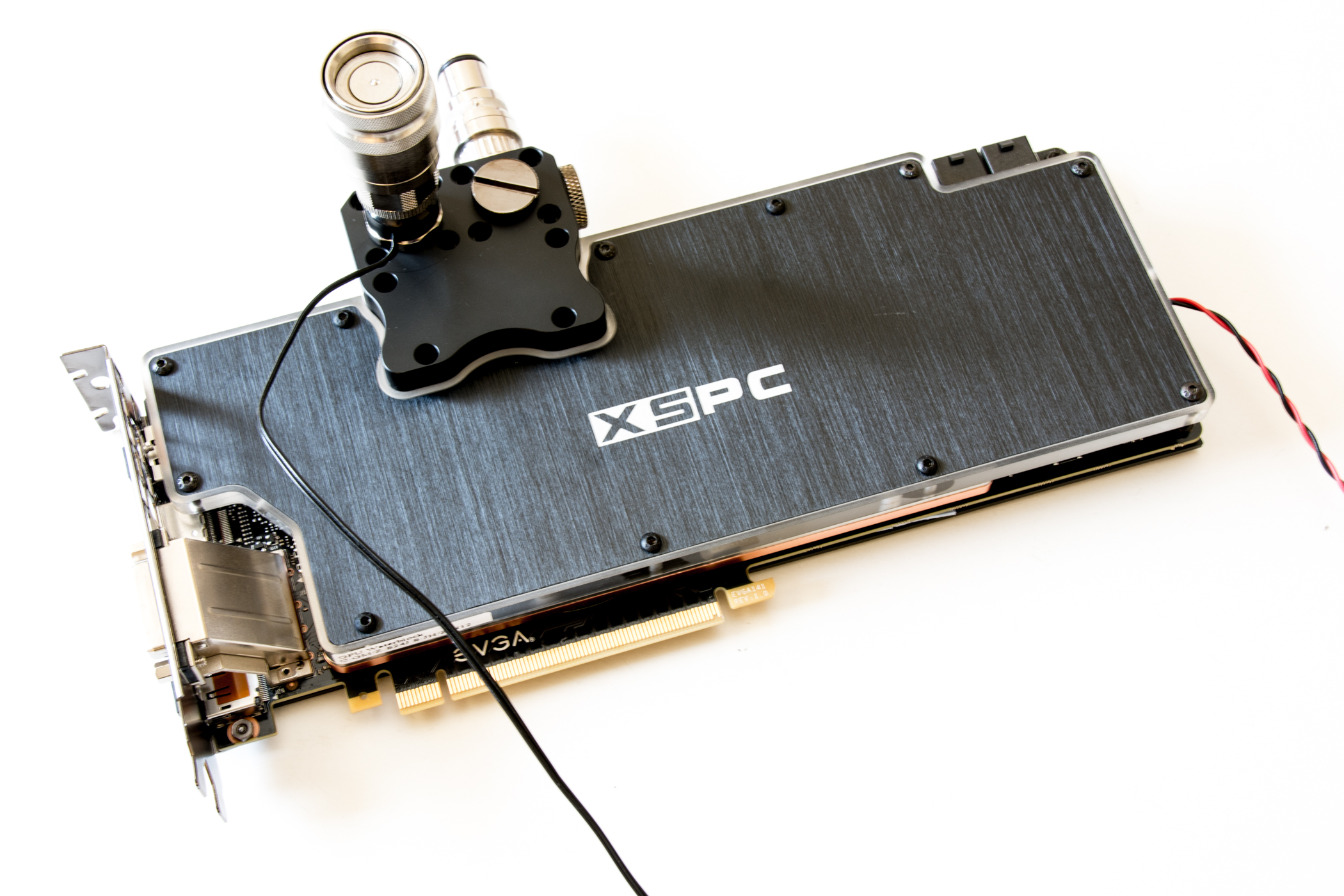
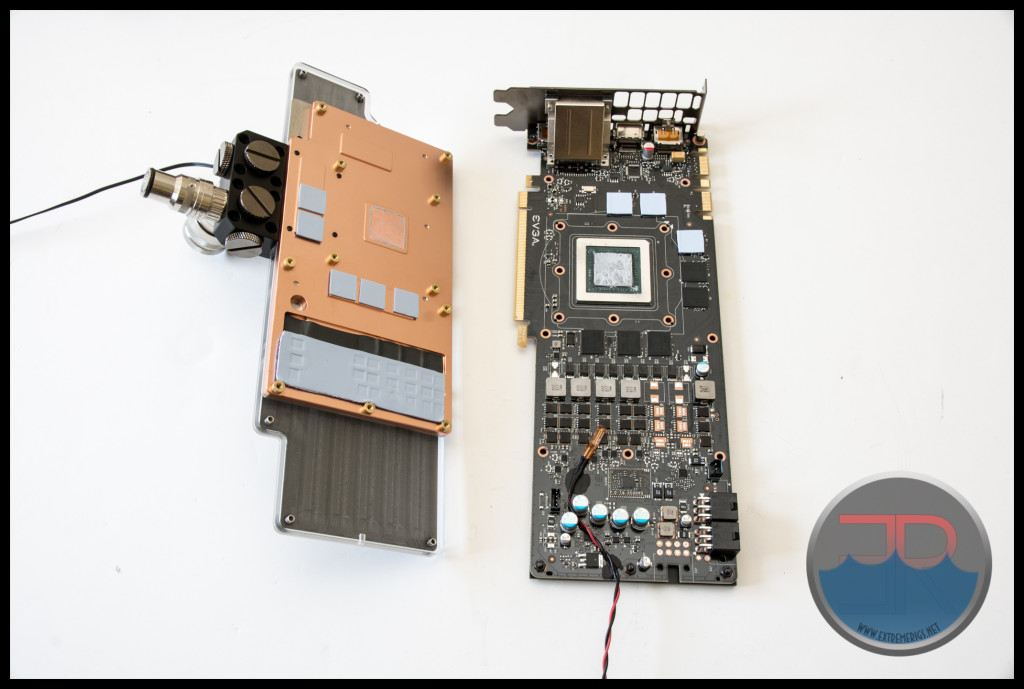
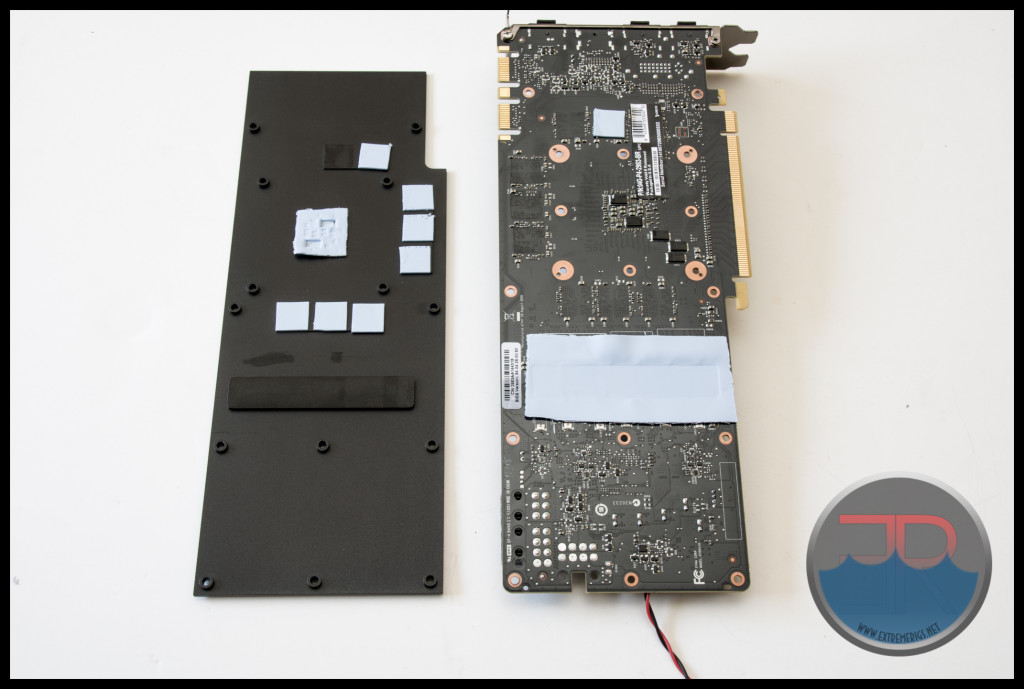
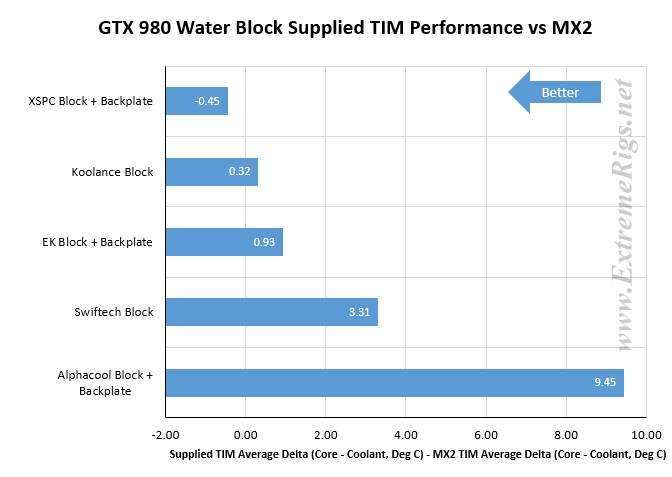



Wait, aren’t you supposed to put washers *under* the back plate?
Well that’s the interesting thing – the backplate doesn’t come with instructions so it wasn’t clear. I’m used to a methodology that a washer gets inserted between the part that can turn and the part that is fixed e.g. between the screw and the backplate, or the nut and the pcb etc. So that’s what I default to if the instructions don’t tell me otherwise. In addition putting the washer between the PCB and the backplate means that you have to hold the block and pcb together, align the 10+ washers, then drop the backplate on top without shifting any of the washers. Either it looks ugly with washers out, or it’s hard to mount with washers internal. Looking at the XSPC’s website – it shows the washers in between the backplate and the PCB. I don’t think this affects performance testing at all, but it does negate my aesthetics comments. However I do think the hassle of putting them under the backplate is a negative so the overall rating would be the same even if the points shift from one category to the next!
[…] XSPC XS-GTX-980 Review – XSPC’s GTX 980 Razor Water Block & Backplate […]
Comments are closed.